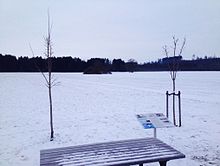Richard W. Higgins
Richard W. Higgins (born August 21, 1922 in Framingham , Massachusetts , † April 5, 1957 in Fürstenfeldbruck ) was a pilot in the United States Air Force . On April 5, 1957, he died near Fürstenfeldbruck from a crash caused by a technical defect. For his previous maneuver, in which he defied the instructions of the control tower and risked his own life in order to prevent the plane from falling into an inhabited area in Fürstenfeldbruck, he achieved posthumously notoriety and various awards.
Life
Richard Higgins studied after his school days at Norwich University - The Military College of Vermont in Northfield (Vermont) . During World War II , Higgins joined the United States Army Air Forces and served the United States as a pilot in 1944. After the war he worked for a company in his hometown for some time, only to join the United States Air Force shortly afterwards . He achieved a total of 2,476 flight hours. Richard Higgins had three children with his wife Elisabeth; At the time of the accident, his son Tuck was nine years old, his daughter Blair six and Peter, who was born in Fürstenfeldbruck in 1955, was just one year old.
death
On April 5, 1957 Richard Higgins got into an emergency situation with an F-84F Thunderstreak of the Luftwaffe with the registration number BA-102 during a workshop flight due to an engine defect over Fürstenfeldbruck. He disregarded the exit order from the control tower and steered the aircraft over uninhabited area, as an exit over the city would inevitably have led to a disaster. The rescue exit initiated afterwards at a height of about 80 meters failed due to the low altitude and Captain Higgins died at the scene of the accident.
Posthumous honors
The city of Fürstenfeldbruck had already named a street after Richard Higgins on April 15, 1957 because of his selfless act at the suggestion of the then 1st Mayor Fritz Bauer.
On April 5, 2000, building 227 at the air base , which formerly served as a school for the children of US soldiers and is now used by the Air Force Officers' School , was renamed the "Captain Higgins Building". In 2007 the officers' school hosted an exhibition on Richard W. Higgins.
At Christmas 2002 the "West Primary School" was renamed Richard Higgins Primary School (later Richard Higgins Primary School ).
Captain Richard W. Higgins was posthumously promoted to major.
Richard W. Higgins is listed as one of four role models by the Air Force - together with Ludger Hölker , Michael Giermeier and Jürgen Schumann .
In spring 2014 a memorial was erected at the crash site.
Web links
- Heiner Möllers: Captain Richard W. Higgins. In: Role Models. Federal Ministry of Defense, November 26, 2013, archived from the original on June 14, 2015 ; Retrieved January 28, 2020 (Air Force history website).
Individual evidence
- ↑ a b c d Harald Meyer: Richard Higgins. A jet pilot saves Fürstenfeldbruck. (PDF) Fighter Bomber Wing 49 e. V., archived from the original on November 5, 2014 ; Retrieved July 26, 2017 .
- ↑ a b Michael Volpert: Richard Higgins died 50 years ago in a plane crash. In: Website of the city of Fürstenfeldbruck. City of Fürstenfeldbruck, April 12, 2007, archived from the original on August 1, 2012 ; accessed on May 3, 2013 : "2 minutes and 18 seconds until the accident"
- ↑ Why is our school called Richard Higgins Elementary School? Richard Higgins Elementary School, accessed January 28, 2020 .
- ↑ Heiner Möllers: Captain Richard W. Higgins. In: Role Models. Federal Ministry of Defense, November 26, 2013, archived from the original on June 14, 2015 ; accessed on March 24, 2020 (website on the history of the Air Force): "People who set an example with their actions."
| personal data | |
|---|---|
| SURNAME | Higgins, Richard W. |
| BRIEF DESCRIPTION | American pilot |
| DATE OF BIRTH | August 21, 1922 |
| PLACE OF BIRTH | Framingham |
| DATE OF DEATH | April 5th 1957 |
| Place of death | Fürstenfeldbruck |


